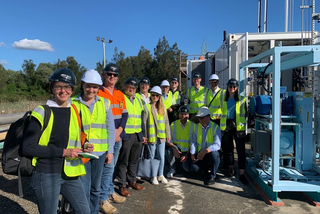
BDI and acatech travel Down Under for hydrogen ramp-up
Since December 2020, the BDI and acatech, the German Academy of Science and Engineering, have been working with an Australian consortium to investigate for the first time whether and how the import of renewable hydrogen from Australia can succeed. The findings from the so-called HySupply project are to pave the way for a long-term hydrogen partnership between the two countries.
The trip to Australia was one of the milestones in the HySupply project. Since the beginning of the project, it has been investigated whether the import of renewable hydrogen from Australia is technically, economically and regulatory feasible. The preliminary results show that Australia can be an important and reliable partner for a long-term hydrogen partnership for Germany in the future.
In order to leverage this potential and support the implementation of the German-Australian supply chains for renewable hydrogen, a BDI delegation accompanied by the Federal Ministry of Education and Research and a number of leading companies and experts from academia travelled to Australia.
The first day of the trip began in Perth in the west of the continent, which, apart from its many hours of sunshine, is also known for its rich deposits of raw materials and critical minerals. Western Australia has half of the chemical elements in the periodic table. But Western Australia is also way ahead in terms of hydrogen: similar to liquefied natural gas, the state is able to export large quantities.
The second day began at four o'clock in the morning to fly from Perth to Sydney in the Australian southeast. There, after a long wait due to Corona travel restrictions, we were finally able to meet our project partners live and in colour on site.
The third day took us to Brisbane, where the delegation was again able to get to know a number of concrete hydrogen projects that are already being implemented. One example is the existing ammonia plant in Gibson Island, which will be converted to the use of renewable hydrogen in the near future and is ready for export.
Then it was off to the last stop in Adelaide where, in addition to the potential, the challenge of bilateral supply chains, especially in the area of infrastructure, were discussed. The Australian South is well positioned due to its experience in exporting raw materials and critical minerals.
Conclusion of the trip: In addition to the tangible opportunities and potential for a long-term and reliable hydrogen partnership with Australia, there are still barriers to the implementation of bilateral supply chains that need to be overcome as soon as possible. The number one problem is "offtake", i.e. making commitments to purchase the renewable hydrogen in times of uncertain regulatory framework. The second challenge is the cost of electrolysers, which are still not produced on a sufficient scale and in an automated way.
Another uncertainty is the issue of certification: How is a global market to be organised if the requirements are not uniformly regulated? Finally, in addition to the question of export readiness, there is above all the question of import and distribution readiness in Germany and Europe. Here, politics must urgently create the necessary hydrogen infrastructures - especially with the shortening and acceleration of planning and approval procedures for infrastructure project



